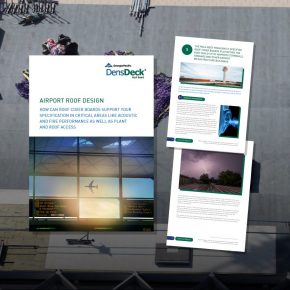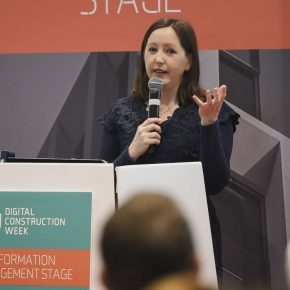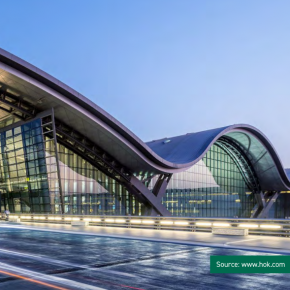
DensDeck: The roles roof cover boards play within the airport roof build-up
From additional acoustic performance to increased fire resistance, roof cover boards offer an array of benefits for any mission critical commercial roofing project. Georgia-Pacific, the manufacturer of DensDeck® Roof Boards, explains more…
Roof cover boards are rigid substrates manufactured from various materials. They are traditionally installed between the insulation and the waterproofing layer of a flat roof system as cover boards. When used as roof boards, they are mechanically fixed or adhered directly to the roof deck. The type of cover board used should reflect the project specifics and will fall into the following categories:
– Acoustic flat roof board
– Weather resistant roof board
– Fire resistant roof board
– Roof access board
– Reduced maintenance of the roof
How can roof cover boards improve airport roof acoustic performance?
Management of acoustic performance is critical for passenger and airport personnel comfort. The clarity of any communication over audio equipment is paramount to user experience and safety. Some manufacturers of cement boards claim that the high mass of cement boards implies that they are better suited to acoustic control.
However, the specific acoustic requirements in airport buildings can be achieved by specifying a roof assembly with lighter glass mat-faced gypsum core cover boards. This piece looks at these two types of roof cover boards specifically.
Roof or cover boards, when installed in their relevant positions within a roof assembly will each help improve the acoustic performance of the airport roof differently. Positioned as roof boards directly on a steel or timber roof deck, they can reduce noise transmission through a roof. To help with acoustic absorption, cover boards are often installed over the insulation layer.
The exact design of the airport roof build-up and placement of the glass mat-faced gypsum board will reflect the project’s specific acoustic requirements. It is not uncommon for the boards to be installed in both positions. Acoustic testing can confirm that the roof build-up satisfies the design requirements.
Can roof cover boards impact airport roof fire resistance?
Cement, gypsum and fibreglass are typically classified as non-combustible materials. This means that both cement and mat-faced gypsum core cover boards have the potential to contribute to the fire resistance of a roof build-up. The chemical makeup of gypsum makes it highly effective for this role.
When gypsum is exposed to high temperatures, the surface releases steam as the chemically combined water in the core is released. Heat transmission is naturally resisted until this slow process, known as calcination, is complete.
Although most cement and mat-faced gypsum boards are fire rated to EN 13501-1 class A, this should be verified against the manufacturer’s technical documentation. We should also keep in mind that FM Approval has its own fire performance approval testing.
What is the impact of a roof cover board on the weather resistance of an airport roof?
In recent years, the increased frequency and force of adverse weather instances in the UK, and Europe, indicate a long-term trend of storms tracking towards this area. Specification of gypsum core and cementitious roof cover boards is increasing as the construction industry looks to mitigate the risk of damage to flat and low slope roofs from such events.
Both types of cover boards are homogenous substrates capable of providing a robust fixing platform for a variety of mechanically fixed and adhered roof coverings. This strong platform can increase the wind uplift resistance of airport flat roof build-ups. Some cover boards have been tested in this area and figures are available from respective manufacturers. Alternatively, FM Approval’s RoofNav database contains over a million assemblies with roof uplift ratings.
Some gypsum core cover boards can also offer increased resistance to hail strikes and flying debris for single ply roof coverings. When correctly installed, these roof cover boards can help improve the moisture resistance of the entire roof build-up.
Roof cover boards and maintenance/lifetime cost of an airport roof
Gypsum core and cementitious cover boards also provide a strong, flat and stable surface to which various types of roof coverings for airport roofs can be adhered or mechanically fixed.
Both types of cover boards can help remove any irregularities other substrates may have, resulting in a more aesthetically pleasing finish for adhered membranes. The inclusion of glass mat facers promotes a more homogenous spread of adhesives to help ensure a strong bond with the roof membrane. Fibreglass mat facers can also increase material compatibility and help prevent blistering of roof membranes.
The even surface of these cover boards forms a platform that can help improve the resistance of the waterproofing layer to accidental penetration that would allow moisture into the build-up, damaging the insulation layer. As a result, the potential repair requirements for this type of roof can be reduced and its life cycle extended.
If the insulation layer within the airport roof build-up becomes compressed, indentions can form. This can lead to water accumulation that can sit in these ‘ponds’. If a roof suffers from ponding, the membrane can come under increased attack from UV etc, as the standing water ‘amplifies’ the sun. Cover boards can help prevent this by helping protect the insulation layer from compression.
Roof cover boards supporting airport roof access
The high compressive strength of cementitious and gypsum core cover boards means they can make installing an airport roof system easier and faster. This is especially the case with metal standing seam roof systems and roof construction that includes roof membranes with a large amount of detailing
Whilst both types of cover boards have excellent compressive strength and can withstand static and dynamic loads, excessively heavy loads and frequent and heavy foot traffic can cause the board to fracture. The boards are ideal for strengthening the roof build-up and reducing stress on some types of waterproofing membranes caused by heavy equipment such as heating, cooling and ventilation (HVAC) plant or risks related to the installation of solar panels on roofs.
The cover board also helps to protect the often most expensive roof build-up component, the insulation layer, from compression that could compromise its performance. This makes roof access less of a concern. The cover board can also help protect single-ply roofing membranes from punctures caused by accidentally dropped tools or flying debris.
DensDeck roof cover boards and airport roof performance
DensDeck® is a brand of high-performance roof cover boards. The glass mat faced gypsum core roof cover boards are designed to address the specific challenges of commercial structures in various mission critical sectors and infrastructure projects such as passenger airports, cargo facilities and airbases worldwide.
To learn more about the role roof cover boards play in the specification of the roof build-up in airport buildings, you can download the ‘Airport roof design’ white paper or contact one of the company’s team, who will be happy to help.
Georgia-Pacific Building Products
133 Peachtree Street, NE, Atlanta
GA 30303
(USA) 1-800-225-6119
Visit Supplier's page
Latest news

30th April 2025
Digital Construction Week announces seminar programme for its landmark 10th edition
Digital Construction Week (DCW) returns to ExCeL London on 4 – 5 June 2025 with its most impactful programme yet. It brings together the best and brightest from across AECO, for two days of practical learning and idea sharing.
Posted in Articles, Building Industry Events, Building Industry News, Building Products & Structures, Building Services, Building Systems, Exhibitions and Conferences, Information Technology, news, Restoration & Refurbishment, Retrofit & Renovation, Seminars
29th April 2025
Senior pledges to ‘bee’ part of the solution with new biodiversity initiative
Senior Architectural Systems has installed its first on-site beehive, marking another step forward in its commitment to sustainability and biodiversity.
Posted in Articles, Building Industry News, Building Products & Structures, Building Services, Curtain Walling, Doors, Glass, Glazing, Innovations & New Products, news, Restoration & Refurbishment, Retrofit & Renovation, Sustainability & Energy Efficiency, Walls, Windows
29th April 2025
West Fraser range delivering key benefits for South-East carpentry company
An experienced carpenter and building site manager who has recently set up his own company is using high performance panel products from the West Fraser range.
Posted in Articles, Building Industry News, Building Products & Structures, Building Systems, Case Studies, Garden, Restoration & Refurbishment, Retrofit & Renovation, Sustainability & Energy Efficiency, Timber Buildings and Timber Products
29th April 2025
CPD Courses Available Online From Ecological Building Systems
Ecological Building Systems, a leading supplier of natural building products for sustainable construction, has revealed its comprehensive CPD programme for the year ahead.
Posted in Articles, Building Industry Events, Building Industry News, Building Products & Structures, Building Services, Continuing Professional Development (CPD's), Information Technology, Innovations & New Products, Insulation, Restoration & Refurbishment, Retrofit & Renovation, Seminars, Sustainability & Energy Efficiency, Training, Walls, Waste Management & Recycling
 Sign up:
Sign up: 